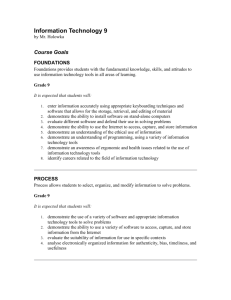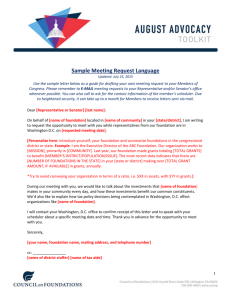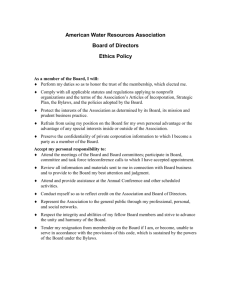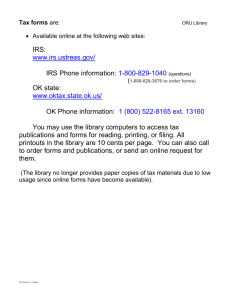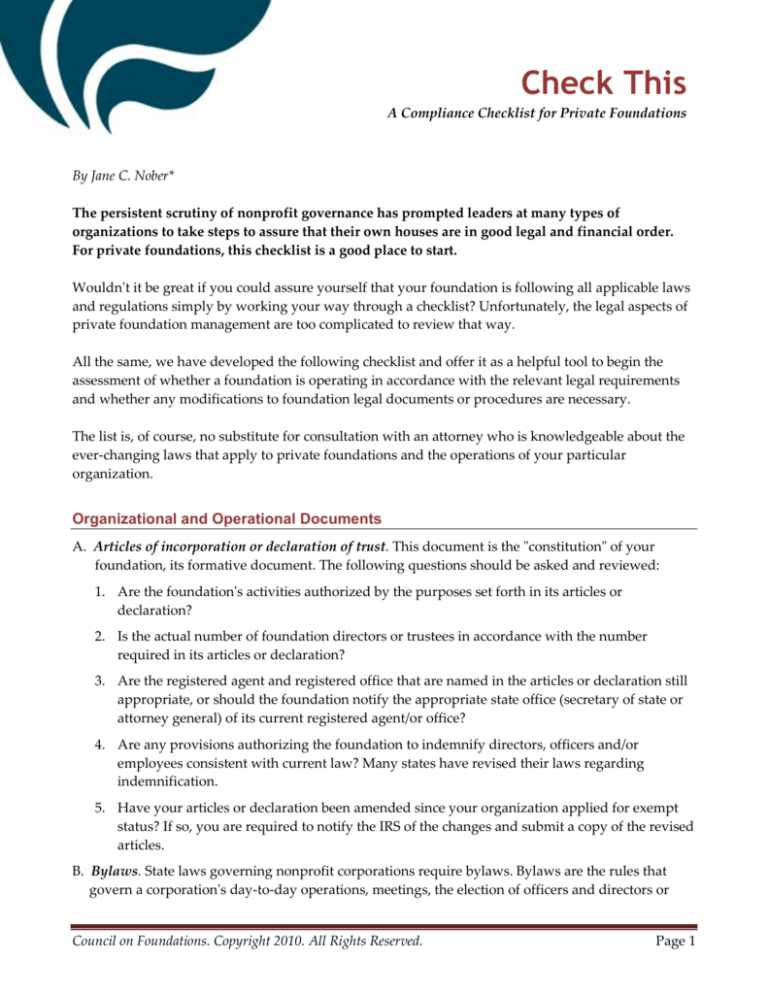
Check This
A Compliance Checklist for Private Foundations
By Jane C. Nober*
The persistent scrutiny of nonprofit governance has prompted leaders at many types of
organizations to take steps to assure that their own houses are in good legal and financial order.
For private foundations, this checklist is a good place to start.
Wouldn't it be great if you could assure yourself that your foundation is following all applicable laws
and regulations simply by working your way through a checklist? Unfortunately, the legal aspects of
private foundation management are too complicated to review that way.
All the same, we have developed the following checklist and offer it as a helpful tool to begin the
assessment of whether a foundation is operating in accordance with the relevant legal requirements
and whether any modifications to foundation legal documents or procedures are necessary.
The list is, of course, no substitute for consultation with an attorney who is knowledgeable about the
ever-changing laws that apply to private foundations and the operations of your particular
organization.
Organizational and Operational Documents
A. Articles of incorporation or declaration of trust. This document is the "constitution" of your
foundation, its formative document. The following questions should be asked and reviewed:
1. Are the foundation's activities authorized by the purposes set forth in its articles or
declaration?
2. Is the actual number of foundation directors or trustees in accordance with the number
required in its articles or declaration?
3. Are the registered agent and registered office that are named in the articles or declaration still
appropriate, or should the foundation notify the appropriate state office (secretary of state or
attorney general) of its current registered agent/or office?
4. Are any provisions authorizing the foundation to indemnify directors, officers and/or
employees consistent with current law? Many states have revised their laws regarding
indemnification.
5. Have your articles or declaration been amended since your organization applied for exempt
status? If so, you are required to notify the IRS of the changes and submit a copy of the revised
articles.
B. Bylaws. State laws governing nonprofit corporations require bylaws. Bylaws are the rules that
govern a corporation's day-to-day operations, meetings, the election of officers and directors or
Council on Foundations. Copyright 2010. All Rights Reserved.
Page 1
Check This
trustees and other governance issues. Some foundations organized in trust form have also adopted
bylaws to guide their managers. The following questions should be asked and reviewed:
1. Are meetings of directors or trustees held at the times and in the places required by the
bylaws? Is an annual meeting required by state law?
2. Are notices of meetings given (or appropriate waivers obtained) in accordance with the notice
requirements in the bylaws?
3. Are the activities of each officer of the foundation consistent with the activities prescribed for
such office in the bylaws?
4. Does your foundation have all of the officers that its bylaws require it to have?
5. Do the bylaws require the existence of an advisory committee or any other such group? If so,
does your foundation have such a committee or group, and are its actions in accordance with
the rules set forth in the bylaws?
6. Are your foundation's procedures for naming new and substitute directors and officers carried
out as directed in the bylaws?
7. Are additional bylaws desirable to govern activities of your foundation or its managers that
are not fully delineated in the current bylaws?
8. Do the bylaws authorize such things as the holding of meetings by telephone or other virtual
means or action by the directors by unanimous written consent, instead of the holding of a
regular meeting? Most states allow board meetings to take place virtually under the condition
that all board members can hear one another simultaneously. This would include, among
others, teleconferencing, videoconferencing and web conferencing. A few states, while
allowing virtual meetings, require the full board to consent to meeting virtually.
HINT: E-mail can be a handy way for scattered directors to reach consensus on foundation issues, but
most states have not yet amended their nonprofit corporation laws to permit voting by e-mail. Those
that do may require unanimous votes, which may be practically unfeasible. In addition, there are some
that question how secure voting by email is. Check to see what your state allows before relying on a vote
taken by e-mail.
9. Are indemnity provisions consistent with current law and your Articles of
Incorporation?
10. If the bylaws require use of a corporate seal, does your foundation have such a seal and is it
used regularly?
HINT: You don't have to have a corporate seal if you don't want one. Usually, you can amend your
bylaws to eliminate the corporate seal.
11. Do the bylaws require certain financial accounting activities, and, if so, are your foundation's
actual activities in accordance with these requirements?
12. Does anything in the bylaws conflict with statements made on your foundation's application
for its federal tax exemption? If your bylaws have been amended since you applied for
Council on Foundations. Copyright 2010. All Rights Reserved.
Page 2
Check This
exemption, have you sent the IRS a copy? IRS rules require that you provide them with a copy
of your bylaws if they have changed.
13. Are your bylaws consistent with both state law and your articles of incorporation? If not, your
bylaws will need to be amended.
Documents Relating to Federal Tax Exemption
You should be familiar with the following documents relating to your foundation's exemption from federal
income tax and be sure they are kept in a safe place:
A. Form 1023, the application for recognition by the Internal Revenue Service (IRS) as a tax-exempt
organization. You need to keep a complete copy of the application along with all attachments and
schedules. You should also keep copies of any correspondence between your organization and the
IRS relating to the application.
B. Form SS-4, the application for employee identification number.
C. The IRS's favorable determination letter certifying that your foundation is exempt from income
tax and specifying that it is a private foundation or a private operating foundation.
Hint: You should check IRS Publication 78, The Cumulative List of Organizations Contributions
to Which Are Deductible Under Section 170(c) periodically to be certain that your foundation is
listed accurately. Private foundations are indicated by a footnote "4" and operating foundations by
a footnote "3."
D. Any IRS letters approving your foundation's grantmaking procedures. Such a letter is normally
required for grants to individuals for study or travel or for set-asides (see below).
E. Any other official correspondence from the IRS concerning the status or operations of the
foundation including private letter rulings or audit findings.
Documents Relating to State Tax Exemption
You should be familiar with any documents granting or denying your foundation's exemption from state
income, sales, property or franchise taxes and be sure they are kept in a safe place.
Special Private Foundation Rules
(Internal Revenue Code, Title 26, Chapter 42, and Code of Federal Regulations (Treasury
Regulations), Title 26, Part 53)
A. Internal Revenue Code (IRC) § 4940 imposes an excise tax on net investment income, which is
due on the 15th day of the fifth month after the close of the foundation's tax year; however,
estimated taxes must be paid during the year based on the same rules applicable to for-profit
corporations. The tax is 2 percent and may be reduced to 1 percent if the foundation meets certain
maintenance of effort tests.
Council on Foundations. Copyright 2010. All Rights Reserved.
Page 3
Check This
1. Be familiar with these tests so that you can advise the foundation about designing a system to
determine when meeting these tests might be most advisable.
2. Be familiar with the definition of "net investment income" and be certain that adequate
recordkeeping procedures are in place to keep track of all expenses that can be attributed to
the production of investment income.
B. IRC § 4941 prohibits all acts of self-dealing , which are defined generally as financial transactions
with disqualified persons (such as substantial contributors, related corporation and foundation
board members and their families) using foundation funds. A 10 percent initial excise tax is
imposed on the self-dealer. In addition, a five percent tax is imposed on foundation managers
who participated in the transaction knowing that it was self-dealing; the tax on foundations
managers is capped at $20,000 per act of self-dealing.
1. Understand the definition of disqualified persons as set out in IRC § 4946. Ingeneral,
disqualified persons include substantial contributors to the foundation and foundation
managers as well as certain family members of these contributors and managers. Note that the
term “persons” is not limited to individuals so may include other entities like a
corporation.
2. Review arrangements for payments for personal services, offices and facilities, transportation,
and the like that involve disqualified persons to be certain it is reasonable compensation for
personal services that are necessary to the foundation's charitable operations.
3. Review the use of any tickets or other tangible benefits resulting from grants and make sure
they are either declined or handled properly (for more on this topic, read this article).
4. Review banking and investment dealings with banks that are disqualified persons to be sure
they fit within the narrow exceptions from the self-dealing rules for general banking services
[Treas. Reg. 53.4941(d) – 2(c)(4)]
5. Note restrictions on direct or indirect payments to "government officials."
C. IRC § 4942 imposes a minimum payout requirement for private foundations. This payout is
roughly the equivalent of five percent of net investment (non-charitable) assets. The first tier tax
on the foundation is 30 percent of any undistributed amount.
1. Be familiar with how this payout requirement is calculated paying particular attention to the
definition of "qualifying distributions" which includes not only grants (with the exception of
grants from private non-operating foundations to certain types of public charities classified as
supporting organizations in certain situations), but also necessary and reasonable
administrative expenses to accomplish the grant program and other direct charitable activities
as well as the acquisition of assets for charitable purposes, program-related investments and
set-asides.
2. Understand how assets are calculated. Assets are measured using a monthly average formula;
certain assets such as real estate must be valued on the basis of a qualified appraisal that is no
more than five years old.
Council on Foundations. Copyright 2010. All Rights Reserved.
Page 4
Check This
3. Apply a credit for any investment income taxes paid.
4. Understand that qualifying distributions that exceed the minimum required may be carried
over and applied to later years (up to five). The payout must be met no later than 12 months
after the end of the tax year in question; in other words, payments in the following year may
be applied retroactively to make up any shortfall.
5. Design accounting and recordkeeping procedures to provide accurate and reliable information
for these calculations.
D. IRC § 4943 prohibits a foundation in conjunction with all of its disqualified persons from having
excess business holdings (a controlling interest in a for-profit company, partnership, etc.). The
first tier excise tax on a foundation that violates these rules is 10 percent of the fair market value
of excess business holdings that are held beyond the permitted time period; the permissible
holding period is generally five years.
1. Determine whether any such holdings exist or whether they might be created by additional
purchases by disqualified persons.
2. Plan for any required divestiture and design a method for keeping track of the holdings of all
disqualified persons.
3. Know that regardless of the percentage owned by disqualified persons, the foundation need
not divest if its holdings are less than two percent.
4. Know that excess holdings acquired after 1969 must be divested within five years, although an
additional five years may be granted by the IRS Commissioner under limited circumstances.
E. IRC § 4944 imposes a penalty on the foundation and its managers for any investment that might
jeopardize the carrying out of any of the foundation's exempt purposes (jeopardy investment). A
tax is imposed upon the foundation and foundation managers that participated in making the
investment knowing that it was a jeopardy investment. The tax rate for violating these rules is 10
percent of the investment on the foundation and 10 percent of the investment on foundation
managers. The maximum first tier tax for foundation managers is $10,000 per investment.
1. Know that no type of investment is per se a jeopardy investment, but certain types are subject
to special scrutiny (commodities futures, trading on margins, working interests in oil and gas
wells, "puts" and "calls", etc.).
2. Be familiar with the definition of a "program related investment," which is an exception to the
jeopardy investment rules. For example, a below-market interest loan to a minority lowincome housing development company could meet the definition, avoid the jeopardy
investment prohibition and count toward meeting the minimum payout requirement.
F. IRC § 4945 provides a list of various kinds of grantmaking or other expenditures that can subject a
private foundation and its manager to penalty for making taxable expenditures. For example,
funds spent in support of or in opposition to a political candidate, grants to non-charities and
certain supporting organizations without exercising expenditure responsibility, and grants for
non-charitable purposes would subject a foundation to taxes. The first tier excise taxes for violating
Council on Foundations. Copyright 2010. All Rights Reserved.
Page 5
Check This
these rules are 20 percent of the impermissible expenditure on the foundation and five percent on
foundation managers, with a maximum of $10,000 per expenditure for foundation managers who
participate in making the expenditure knowing the expenditure constitutes a violation.
1. Make sure that the foundation does not spend funds on a political campaign or for a noncharitable purpose. These expenditures are prohibited.
2. Understand when the foundation can advocate and when it cannot. Generally, lobbying is
prohibited, but there are several exceptions including self-defense communications,
responding to written requests from legislative committees, and providing nonpartisan
analysis, study or research.
3. Know that strict rules apply to grants or expenditures for voter registration.
4. Make sure that the foundation has secured advance approval from the IRS before making
grants to individuals for study or travel (scholarships, fellowships, prizes, awards).
5. Exercise expenditure responsibility for grants to non-charities (trade associations, chambers of
commerce, social welfare organizations, labor unions, for-profit companies, etc.).
6. Exercise expenditure responsibility for all grants to private foundations other than exempt
private operating foundations (a very specific type of private operating foundation). Make
sure that the grantee can satisfy the "out-of-corpus" requirement if it is a non-operating
foundation and your foundation wants to count the grant towards its own “payout.”
7. All private foundations must follow expenditure responsibility procedures when making
grants to certain types of supporting organizations. A supporting organization is one type of
public charity.
Administrative Reporting and Public Accountability
A. Establish procedures to supply information required for completing various notice and filing
requirements such as:
1. Form 990-PF, Return of Private Foundation. You should be generally familiar with the
information in the return and should be sure that it is completed accurately. Instructions are
located here.
o
Be sure to report direct charitable expenses correctly.
o
Any transfers to and transactions and relationships with noncharitable exempt
organizations (such as trade associations, or social welfare organizations) must also be
reported on the Form 990-PF (such as loans, rental of facilities, performance of services,
etc.).
2. Quarterly IRS filings and payment of estimated tax, Form 990-W.
3. Annual filings required by state law.
4. SEC annual information returns for very large holdings (over $100 million).
5. For foundations with paid staff:
Council on Foundations. Copyright 2010. All Rights Reserved.
Page 6
Check This
o
FICA (Social Security and Medicare);
o
Federal, state and local income tax withholding; unemployment insurance (FUTA and
any state requirements);
o
Reporting requirements as to fringe benefits under the Employees' Retirement Income
Security Act of 1974.
6. Forms W-9 (instructions here) and 1099-MISC (instructions here) for consultants, professional
fees, director or trustee fees, etc.
7. Special IRS notice requirements for reporting a dissolution or substantial contraction of a
foundation (IRC § 6043 and see § 507).
8. Foundations with unrelated business income must file Form 990-T (income from debt financed
investment property and certain publicly traded partnerships are examples). The Form 990-PF
also has a section on income-producing activities.
The IRS Private Foundation Life Cycle is a very useful tool to ensure the foundation is in
compliance with federal required filings and ongoing compliance. In addition, IRS publication
4221-PF, Compliance Guide for 501(c)(3) Private Foundations explains all the filing and
recordkeeping rules applicable.
B. Foundations that receive contributions from individuals or corporations may have reporting
obligations:
1. A foundation that receives a gift of $250 or more from an individual or corporation must
provide a written acknowledgement to the donor. This acknowledgement should state the
name of the foundation, the amount of the contribution (or describe the property given if it
was something other than cash) and should state whether goods or services were received in
exchange for the contribution (a quid pro quo contribution). In the case of a quid pro quo
contribution, a written acknowledgment must be sent to the donor for any amount donated in
excess of $75. The letter should indicate the name of the donee, the amount contributed, a
statement that the charitable deduction is limited to the amount by which the contribution
exceeds the fair market value of the goods/services received by the donor, as well as a good
faith estimate of the amount of those goods and services received. Where the donated property
is valued at over $5,000 and is something other than cash or publicly traded stock, it may be necessary
for the donor to complete Form 8283, Noncash Charitable Contributions, and file this form
with the donor's tax return. The foundation will have to sign this form. If the donated
property is sold within three years of the gift, the foundation must complete and file Form
8282, Donee Information Return. Further reporting requirements may apply when the
donation involves certain types of property, for example, a vehicle (see IRS Publication 4302, A
Charity’s Guide to Vehicle Donations).
2. Where a foundation manager contributes more than $5,000 to the foundation and the amount
contributed is more than 2 percent of the foundation's total contributions, the foundation manager
must be listed in Part XV, Line 1(a) of the foundation's 990-PF.
Council on Foundations. Copyright 2010. All Rights Reserved.
Page 7
Check This
3. If contributions of appreciated property (other than publicly traded stock) are made to the
foundation and the donor wishes to take maximum income tax deductions, plan sufficient
distributions to meet the "flow-through" requirements under section 170(b) (1) (E). Note also
the need to maintain records and show that such distributions are made out of "corpus" on
Form 990-PF.
See IRS Publication 1771 Charitable Contributions: Substantiation and Disclosre Requirements for
further details. The IRS also has a detailed online FAQ on public disclosure requirements for exempt
organizations.
Public Disclosure Requirements
Every private foundation is required to make certain information available to the public:
1. Copies of the foundation's Form 990-PF filed with the IRS within the past three years must be
made available for public inspection at the foundation's offices or another reasonable
location. In addition, foundations must supply "take-home" copies of such returns to
individuals who request them in writing. Unlike other exempt organizations, private
foundations must disclose the name and address of any contributor to the organization listed
on the 990-PF.
2. If the foundation's Application for Recognition on Form 1023 was on hand or filed after July
15, 1987, this document, as well as any IRS responses, and all relevant correspondence relating
to the foundation's exempt status must also be made available to the public for inspection or
as a "take home" copy.
3. For both the Form 990-PF and the Form 1023, the foundation may charge a requester the actual
cost of mailing the documents and a copying fee that does not exceed 20 cents per page.
4. The public must also have access to Form 990-T, Exempt Organization Business Income Tax
Return, filed after August 17, 2006. Returns must be available for a three-year period
beginning with the due date of the return (including any extension of time for filing). See
Public Inspection and Disclosure of Form 990-T for more information. Also see a Council
resource on this.
5. A foundation may satisfy the requirement of providing copies by making a copy of the
relevant Forms 990-PF, 990-T and 1023 "widely available" on a web site. The site may be
maintained by the foundation or by another group that maintains a database of foundation
documents. The website must (1) inform readers that the document is available and provide
instructions for downloading it; (2) must contain an exact replica of the foundation's
documents; and (3) may not charge a fee for downloading the documents. Note that making
the information widely available does not exempt you from the public inspection
requirement.
6. Foundations should check their state law for any disclosure requirements. For example,
private foundations located in New York State are—under state law—still obligated to publish
an annual newspaper notice that their Form 990-PF is available.
Council on Foundations. Copyright 2010. All Rights Reserved.
Page 8
Check This
Grant Programs and Policies
A. Review grant programs in the light of the self-dealing rules, paying special attention to conflict
of interest situations. Treasury regulations warn that it is an act of self-dealing for a private
foundation to satisfy a legally enforceable personal pledge made by a disqualified person
(for example, an individual, spouse or corporate donor to the foundation) to an independent
charity [Treas. Reg. 53.4941(d) – 2 (f) (1)].
B. Determine status of recipient organizations as private foundations, private operating foundations,
publicly supported charitable organizations, or "other" by consulting IRS Publication 78.
This publication is coded to indicate the status of numerous charitable organizations.
Organizations listed with no code number following their name are "public charities," grants
to which generally do not require expenditure responsibility under Code section 4945 (as
noted earlier, an exception would be grants to certain types of supporting organizations).
Some well-known nonprofit organizations, such as the League of Women Voters and the
NAACP, are not themselves charities, but their section 501(c)(3) affiliates are listed in
Publication 78 as public charities. Note also, however, that federal law permits grants to
"noncharitable" organizations for charitable purposes, provided requirements for expenditure
responsibility are met.
C. Develop procedures and wording for grant letters, especially where expenditure
responsibility provisions may apply [IRC § 4945 (d) (4) and (h)], or where the grantee must
expend the grant in the year following its receipt [IRC § 4942 (g) (3)]. (See sample provisions
here)
D. Don't be intimidated by the expenditure responsibility rules under IRC § 4945. IRS data and the
Council on Foundations' experience indicate that a significant number of Council members
make expenditure responsibility grants as a matter of course. These foundations report that
the expenditure responsibility rules are not burdensome and are generally consistent with
their own grantmaking procedures. Expenditure responsibility can be particularly helpful in
making international grants.
E. Note especially limitations on types of grants (IRC § 4945), such as restrictions on direct or
indirect payments to "government officials" [IRC § 4941 (d) (1) (F) and (2) (G), IRC § 4946 (c)].
Other Issues
A. Insurance. Does your foundation wish to indemnify directors, officers and employees for
legal liabilities that may be incurred while performing their duties? Are the foundation's
indemnification provisions up-to-date with state law? Does your foundation wish to purchase
directors and officers (D&O) liability insurance that would offer coverage for losses and legal
costs related to damage claims? If you already have a D&O policy, you should have a copy of
the policy and be familiar with what it covers, what the premiums are, and when it needs to
be renewed. If you don’t have insurance yet, consider the Council-endorsed D&O Insurance
Policy.
Council on Foundations. Copyright 2010. All Rights Reserved.
Page 9
Check This
B. Contracts. Are all contracts and agreements recorded in written, signed documents, in order
to avoid disputes about the terms of the agreements? Is the foundation in compliance with all
contracts to which it is a party? Is there a written policy for completion and review of contracts
with clear direction from the governing body as to what foundation managers may obligate
the foundation?
C. Real Estate and Other Property. Are all of your foundation's documents of title to real,
personal, and intangible property located in a safe place and in the control of the proper
persons?
D. Employment. Should the foundation have employment contracts with any of its employees? Is
there a clear employment policies and procedures manual? Are the foundation's employment
practices discriminatory? Note: Wrongful termination suits are the claims most often filed under
directors and officers liability policies.
E. Pension. Do the foundation's pension plans conform with the Equal Retirement Income and
Security Act (ERISA)?
F. Permits and Licenses. Does the foundation need a charitable solicitation permit in the states
where it raises funds? Does the foundation need any other licenses or permits? Is the
foundation qualified to do business in every state in which it conducts activities for which
such qualification is required?
G. Copyright and Trademark. Does the foundation hold the copyright on materials that it
publishes? Has it registered those publications with the Copyright Office? Has it received
appropriate permissions to reproduce work created by others? Has the foundation spent time
and money marketing and creating public recognition of its name, slogans or logos? If so, has
the foundation taken any steps to protect those trademarks? Has it registered those marks
with the U.S. Patent and Trademark Office? Note: While registration is optional for both copyrights
and trademarks, there are many benefits that such registration provides.
H. Sales tax. Should your foundation be collecting and paying state or local sales tax?
I.
Minutes. Is the corporate minute book up-to-date and complete? Are the minutes kept in a
safe place?
*Jane C. Nober is former special counsel at the Council on Foundations.
– Updated by Council legal staff in 2010.
Council on Foundations. Copyright 2010. All Rights Reserved.
Page 10

